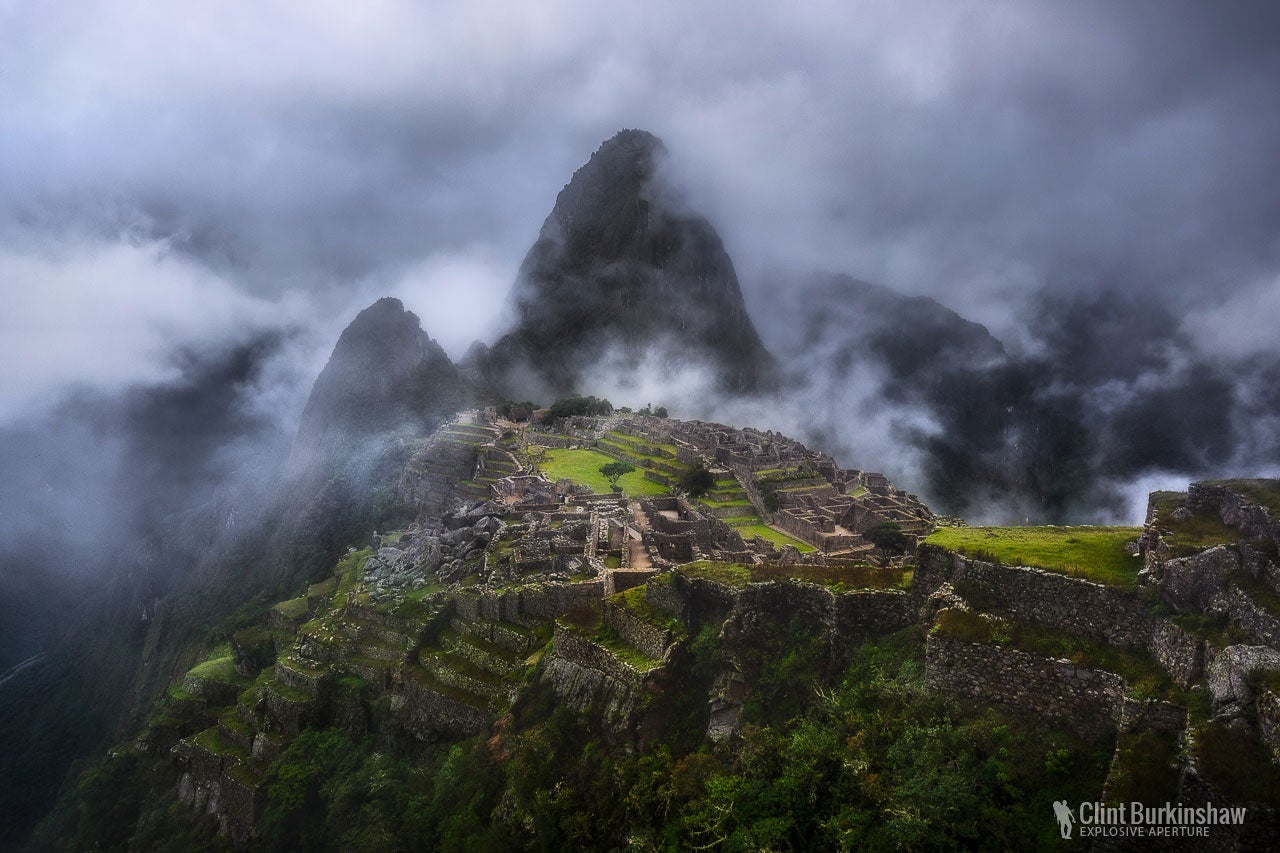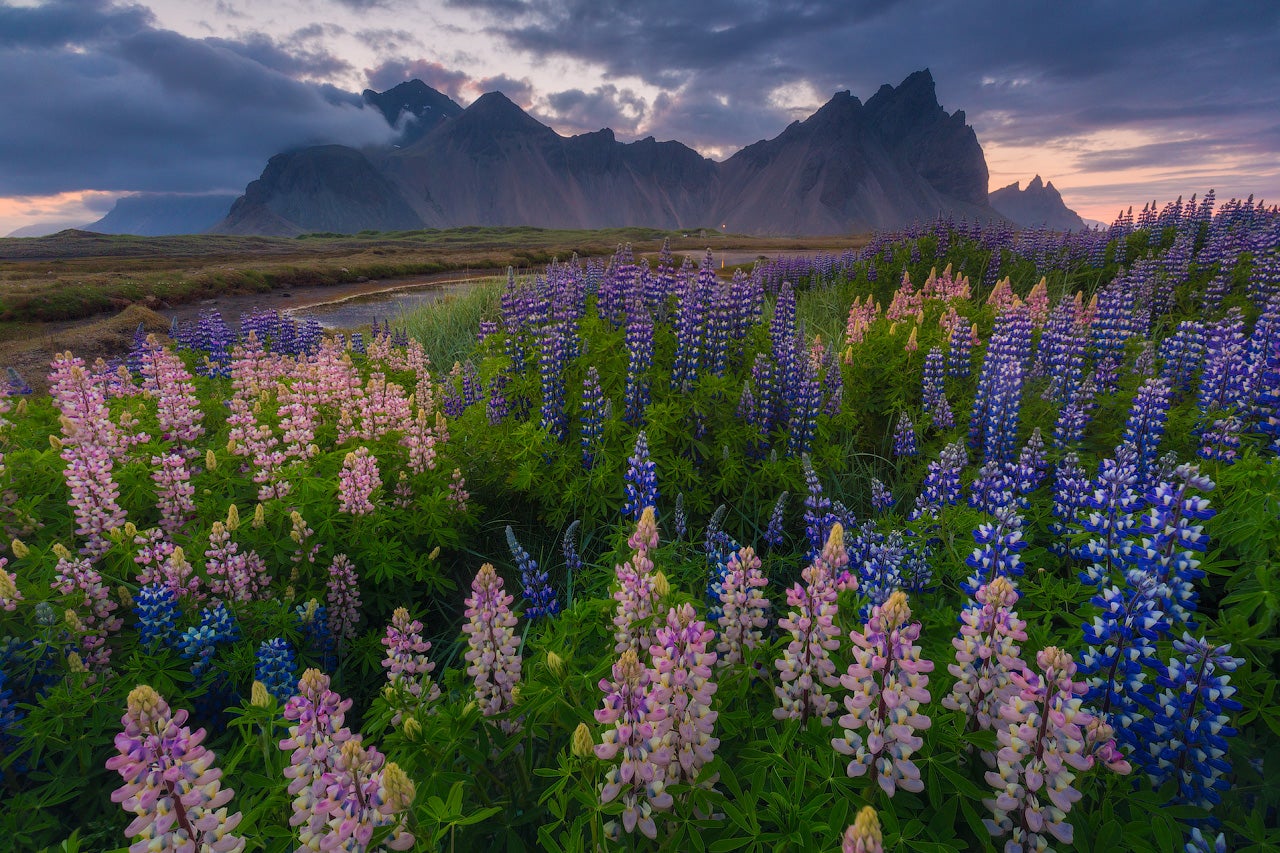
Photography is arguably one of the most versatile mediums for artistic expression ever invented by humans. We can quite literally make photographs of anything present in our world (and beyond) as long as we’re given the correct tools and access to do so. Yet so many of us find ourselves gravitating to one particular facet of photography which remains as simple as it is complex. We’re talking about landscape photography.
- Check out this 12 Days Yunnan Culture and Landscape Photography Tour
- Discover this Ultimate Guide to Landscape Photography
At this risk of starting off this landscape photography tutorial like an eleventh grade book report, the word “landscape” originates from the middle Dutch term “lantscap”... with “lant” of course translating to English as “land” and “scap” approximately to the English word “ship”.
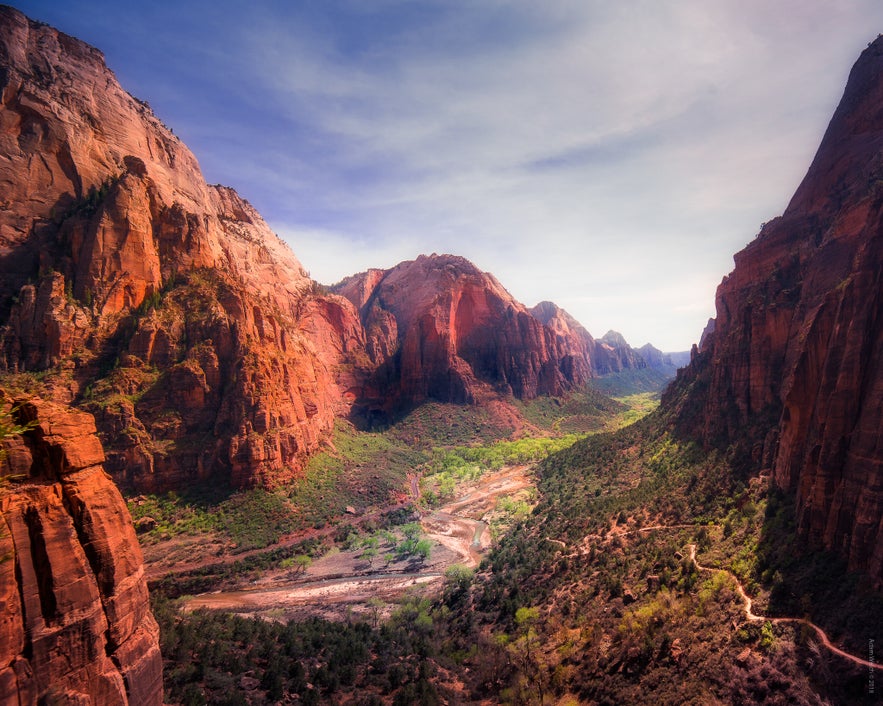 Landscape photography is a far more complex genre than you think it is. Photo by: 'Adam Welch'.
Landscape photography is a far more complex genre than you think it is. Photo by: 'Adam Welch'.
The reason that I want to drill this down immediately is because modern landscape photography has become almost greater than the sum of its parts. It can feel as though we should know everything there is to know about landscape photography and yet somehow, we always find ourselves eager to gaze into gorgeous landscape photographs, no matter how many of them we see.
As such, let's investigate the different types of landscape photography and attempt to explain how this branch of our beloved medium has managed to maintain its long lasting, artistic staying power. We’ll take a brief look at the history of landscape photography and talk about a few famous landscape photographers who have managed to become legends in an already legendary art form. Last but not least, we’ll list some tried and true landscape photography techniques which will help you create more impactful landscape images.
The Art of the Landscape
Why is landscape photography so universally embraced? One reason that it has remained so potent, even in an age where everyone wants to take “pretty pictures”, is that it connects with us on a primordial level.
As humans, we’re drawn to the majesty of the land, even if that land might not be considered traditionally beautiful or even wholly natural. Before I get ahead of myself here, let’s nail down what actually constitutes a landscape.
As it appears in the first generic online dictionary that popped up in my Google search...the definition of “landscape” is as follows:
“...all the visible features of an area of countryside or land, often considered in terms of their aesthetic appeal.”
It’s that last bit, the “aesthetic appeal” which is incredibly important when it comes to making photographs of a landscape. Any piece of ground can be visually appealing but it’s the manner in which we translate the elements within the landscape that can make or break a great photograph.
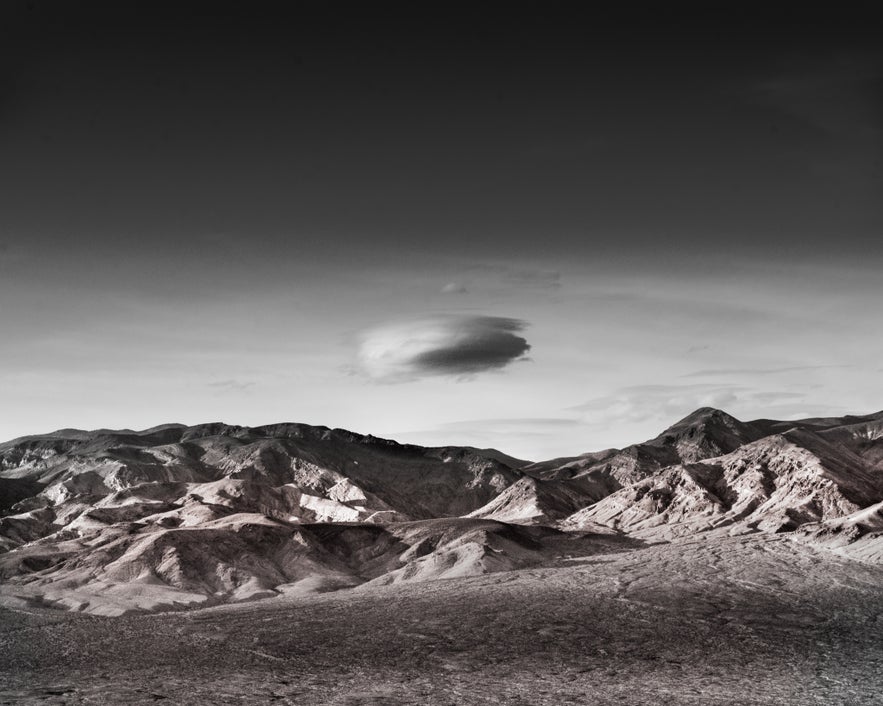 A landscape photo can simply be a snapshot of virtually any area of countryside or land. Photo by: 'Adam Welch'.
A landscape photo can simply be a snapshot of virtually any area of countryside or land. Photo by: 'Adam Welch'.
So in reality, a landscape photo can simply be a snapshot of virtually any area of “countryside or land”. However, that doesn’t always mean it will be an image that you or anyone else might want to see hanging in a frame. A well-made landscape photograph isn’t so much a representation of a location but more of an interpretation. Once you understand this idea, you'll begin to see the world of landscape photography in a whole new light.
An Abbreviated History of Landscape Photography
Painters and other artists have drawn their artistic muses from the landscape for hundreds, if not thousands, of years. Since photography is a relatively fresh visual art (being not even two centuries old yet), photographers such as us are relative newcomers to the art of recording landscapes for visual merits alone.
 We are relatively new to capturing the landscape. Photo by: 'Adam Welch'.
We are relatively new to capturing the landscape. Photo by: 'Adam Welch'.
The oldest surviving photograph on record is this pewter plate below, made by the man who is credited with the invention of photography itself, Joseph Nicéphore Niépce. I was fortunate enough to view it personally at The University of Texas at Austin a couple years ago.
 The oldest surviving photograph at the University of Texas. Photo by: 'Adam Welch'.
The oldest surviving photograph at the University of Texas. Photo by: 'Adam Welch'.
It’s difficult to make out the contents of the photo which was made in 1827. Here’s an enhanced view.
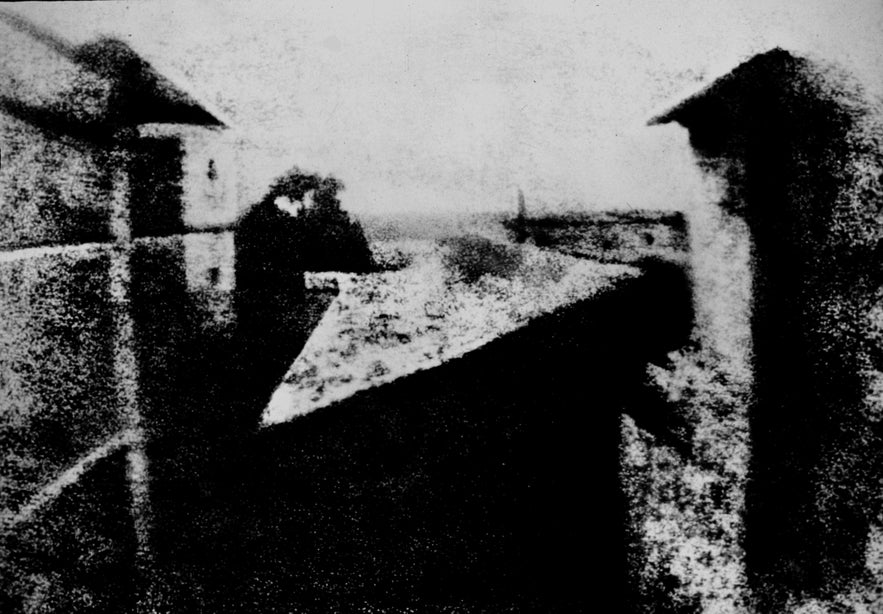 Enhanced view of an image by Joseph Nicéphore Niépce. Photo by: 'Rebecca A. Moss, Director of Visual Resources and Digital Content Lab, College of Liberal Arts Office of Information Technology, University of Minnesota. Wikimedia Commons'.
Enhanced view of an image by Joseph Nicéphore Niépce. Photo by: 'Rebecca A. Moss, Director of Visual Resources and Digital Content Lab, College of Liberal Arts Office of Information Technology, University of Minnesota. Wikimedia Commons'.
You guessed it, it’s a landscape. Well, more of a cityscape actually but we’ll talk more about the difference in just a bit.
Ever since Niépce aimed his camera through his upstairs window all those years ago, there has seemed to always be someone willing to point their camera at a lovely landscape. As difficult as it is to believe, the usage of the word “landscape” has experienced an enormous spike within the last twenty-five years, at least in literary form. Take a look at this graph:
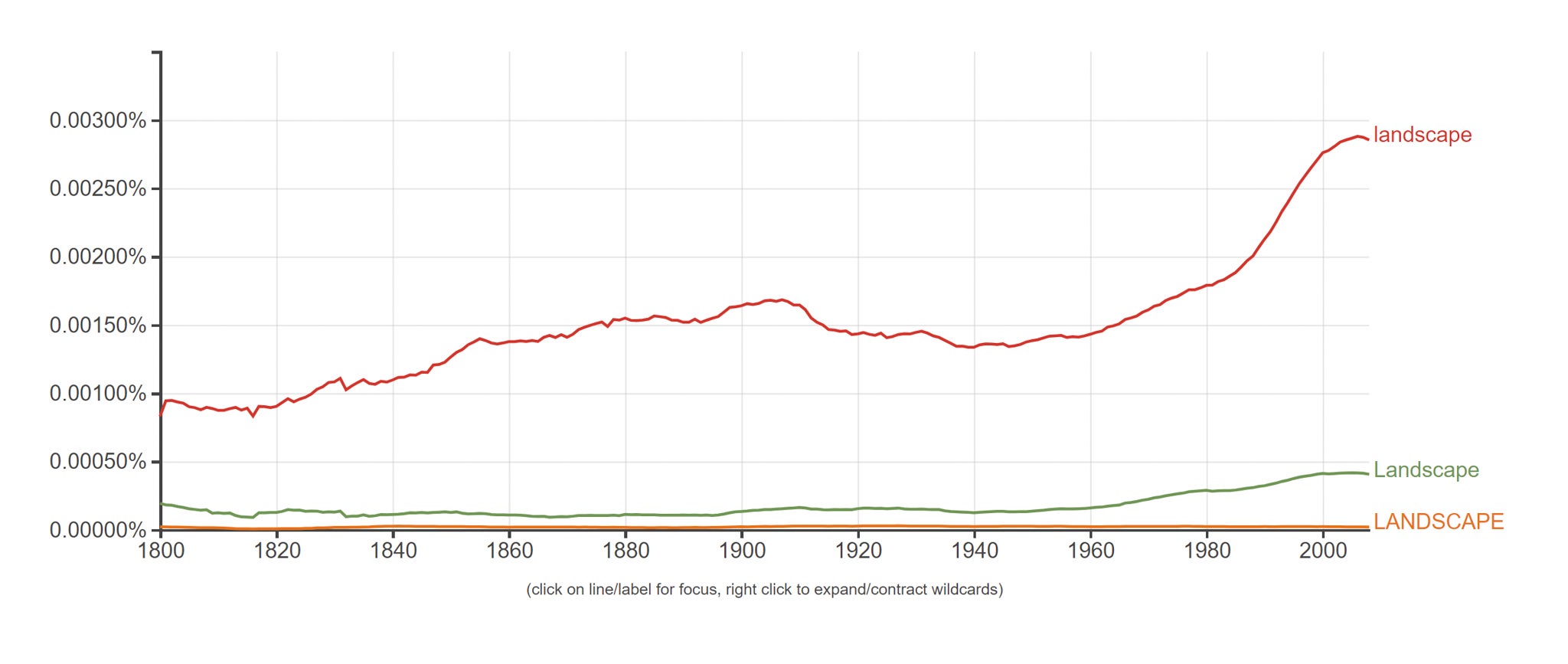 The usage of the word 'landscape' has experienced an enormous spike within the last 25 years. Photo by: 'Adam welch'.
The usage of the word 'landscape' has experienced an enormous spike within the last 25 years. Photo by: 'Adam welch'.
What a coincidence that the incidence of 'landscape' usage seems to have risen dramatically with the increasingly widespread availability of digital cameras, the Internet and social media. Of course, that’s merely the speculation of a slightly obsessive photography writer but it is at least an interesting idea.
Types of Landscape Photography
In the previous section, we mentioned “cityscape” as a type of landscape photography but this is just one of many sub-categories of the landscape genre. The majority of these sub-types generally explain themselves.
A mountainscape is composed primarily of mountains, a cityscape or urban landscape represents city skylines and urban sprawl, seascapes capture the visuals of the oceans, etc. The actual content of the photo ultimately determines the “scape” suffix.
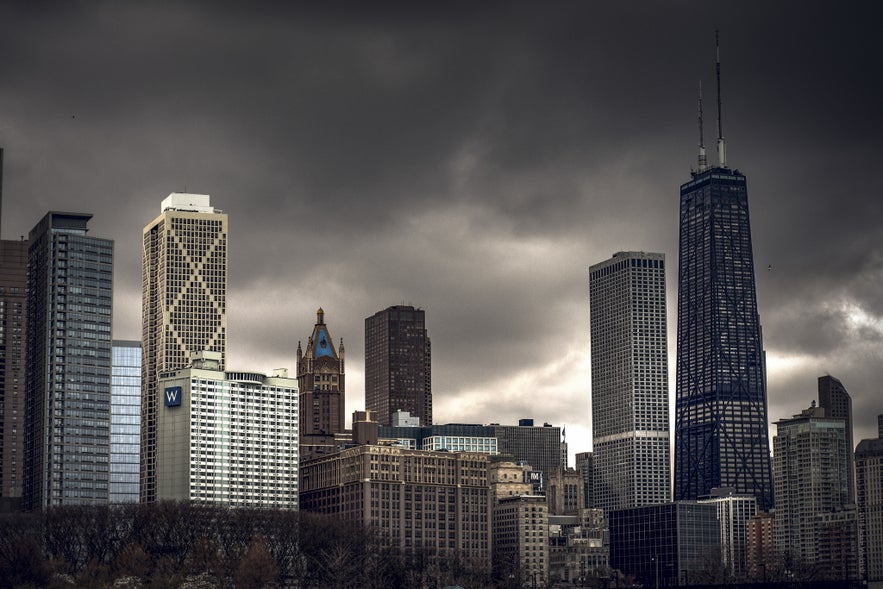 A cityscape is a type of landscape. Photo by: 'Adam Welch'.
A cityscape is a type of landscape. Photo by: 'Adam Welch'.
With that being said, there are a few breeds of landscape photography that sweep across all photos regardless of their scapeism...scapery...scapeatitude??? You get the idea.
Nature or Landscape?
This is the big one; what is the difference between nature and landscape photography? Well, it’s difficult to truly define when nature photography crosses over into landscape photography and vice versa. All nature photography could be considered landscape photography but not all landscape photography has to be nature photography.
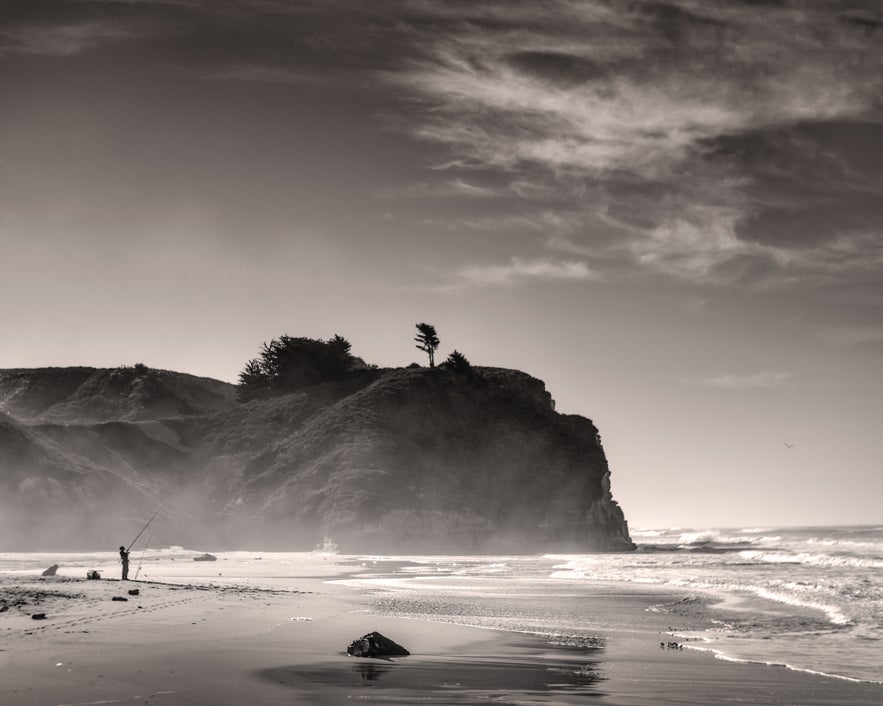 Nature photography and landscape photography are sometimes synonymous, though there are differences. Photo by: 'Adam Welch'.
Nature photography and landscape photography are sometimes synonymous, though there are differences. Photo by: 'Adam Welch'.
Seeing as the naturally occurring world around us is part of the “land”, it stands to reason that nature photography, even on a minute level, could be thought of as condensed landscape photography. However, nature photography is generally considered a separate genre simply because many photographs of our natural world focus on finite environments.
Conversely, landscape photos are large scale renderings of both natural and man-made scenes featuring all sorts of elements including people, animals, structures and objects.
Representational
Landscape photography that is meant to show the inherent qualities of the scene is referred to as 'representational'. Quite literally, a representational landscape photo represents the overall characteristics of a location as you might commonly encounter them.
 Representational landscape photography captures what we see with little manipulation. Photo by: 'Adam Welch'.
Representational landscape photography captures what we see with little manipulation. Photo by: 'Adam Welch'.
Also known as “straight” landscapes, representational landscape photography is a less intrusive form of recording the landscape. This is not to say that representational landscapes can’t be post-processed but rather, the overall appearance should exhibit minimal outside manipulation by the photographer.
Abstract
It might seem a bit oxymoronic to think of landscape photography in terms of anything other than large, sweeping views of vast land expanses but stay with me here. Have a look at this abstract take on some sand dunes in Death Valley National Park, California.
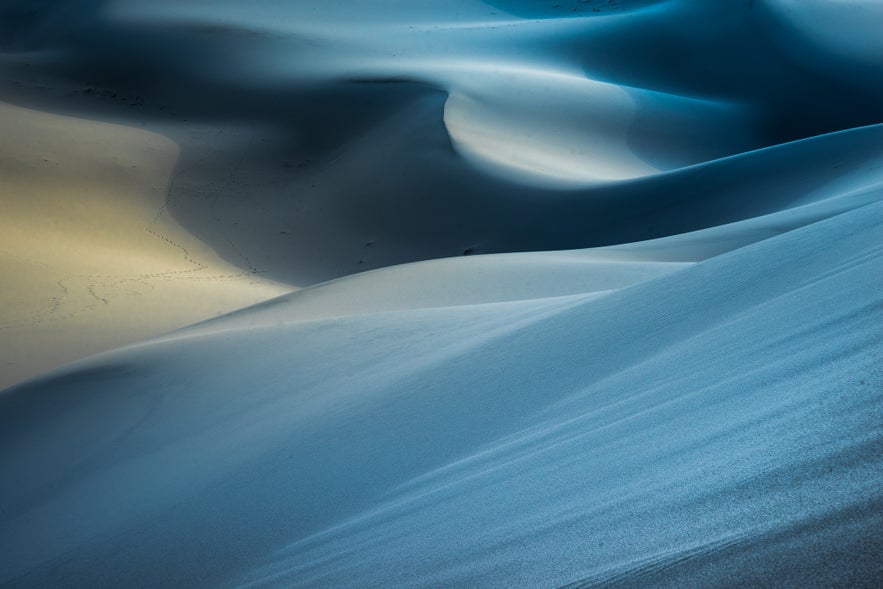 Sand dunes in Death Valley National Park. Photo by: 'Adam Welch'.
Sand dunes in Death Valley National Park. Photo by: 'Adam Welch'.
And this abstract rendering of the iconic Half Dome in Yosemite reflected in the waters of the Merced River.
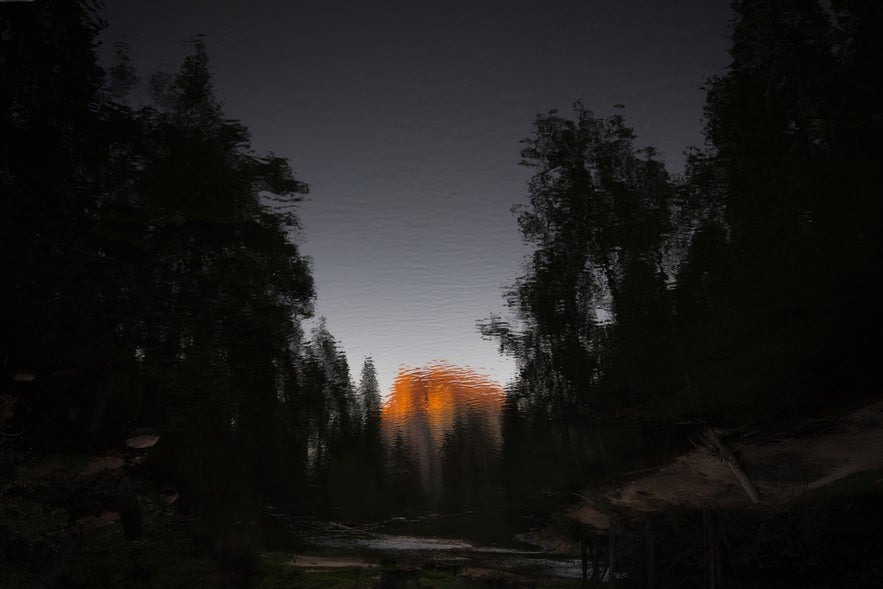 Half Dome reflected in the waters of the Merced River in Yosemite. Photo by: 'Adam Welch'.
Half Dome reflected in the waters of the Merced River in Yosemite. Photo by: 'Adam Welch'.
Abstract landscape photography is a great way to escape a creative funk should you find yourself in one. Not only that but it’s also a refreshing way to breathe new life into overly shot locations.
Impressionistic
This type of landscape photography is a little difficult to identify, mainly due to the fact that it isn’t abstract but it’s not exactly representational either. An impressionistic landscape is one that blends a good amount of creative freedom into the final landscape photograph. This could include photo-blending and other forms of blatant digital manipulations.
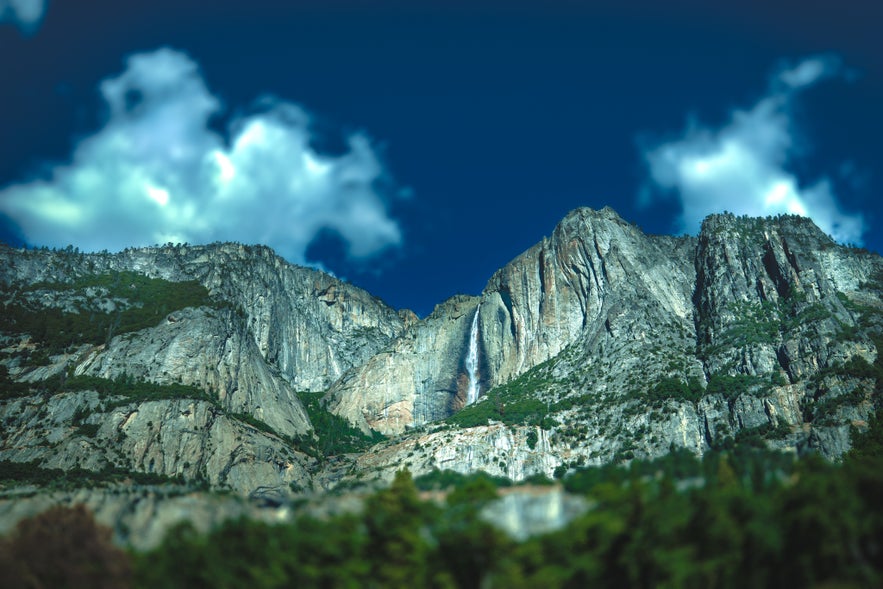 Impressionistic landscape photography gives the photographer an opportunity to display their creative vision freely. Photo by: 'Adam Welch'.
Impressionistic landscape photography gives the photographer an opportunity to display their creative vision freely. Photo by: 'Adam Welch'.
This means that an impressionistic landscape reflects as much about the photographer as it does the landscape itself.
Giants of the Landscape
It’s not an understatement to say there are countless photo makers who we might call “famous landscape photographers”.
At the same time, it’s not exactly fair to characterise them for only their landscape work, as many also produce legendary photographs across other genres. All that withstanding, here are three photographers whose works in landscape photography are more than ordinary. I urge you to explore each of them further.
Ansel Adams
The Man. The Myth. The legendary photographer that the majority of present day landscape photographers still idolise and aspire to emulate. Ansel Adams doesn’t require much of an introduction from me.
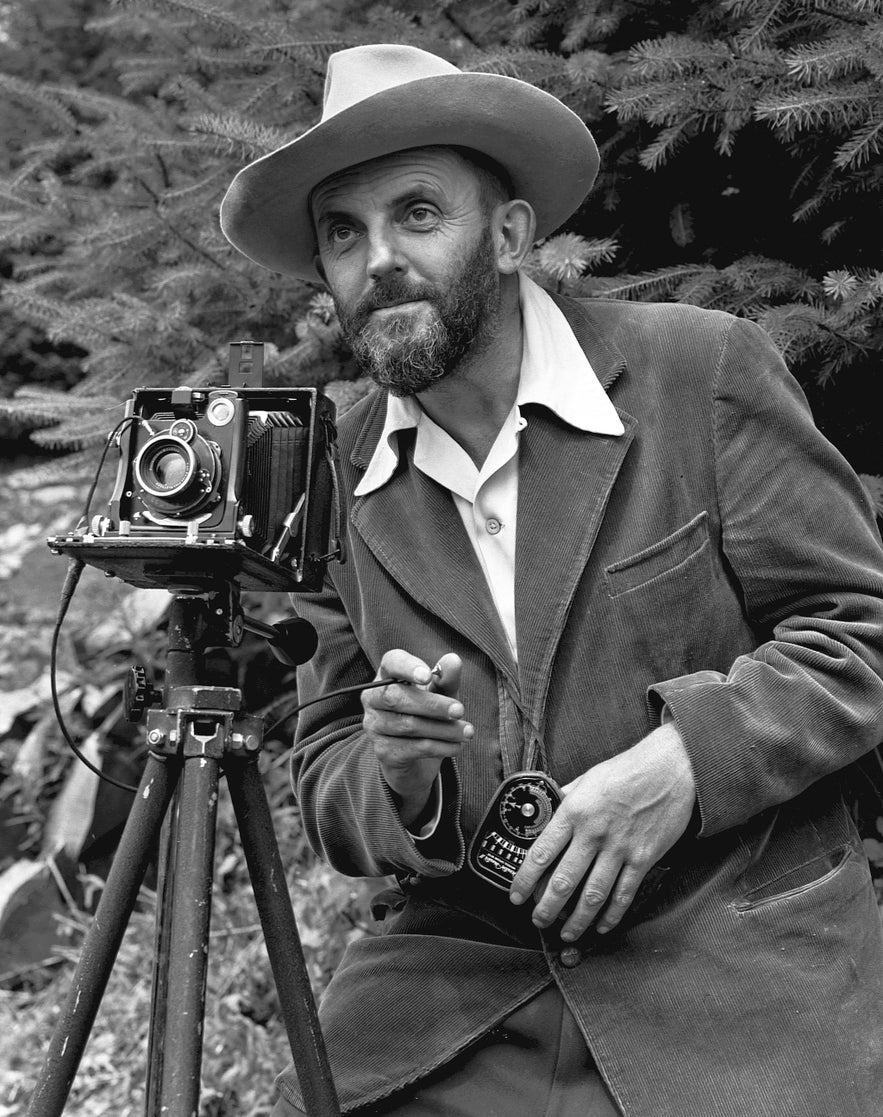 Ansel Adams. Photo by: 'J.Malcolm Greany, Creative Commons'.
Ansel Adams. Photo by: 'J.Malcolm Greany, Creative Commons'.
He produced some of the most iconic photographs of the American landscape. His work in Yosemite and the southwest remains the measuring stick by which many other landscape photos are judged. Not just a prolific photo maker, his interests and influence as a naturalist, author and environmental lobbyist helped to mould many of the photographic and conservational institutions that we enjoy to this day.
You can find some of Ansel Adam’s work here.
Sebastião Salgado
I first discovered the landscapes of Sebastião Salgado about six years ago. Each time I’m fortunate enough to see his work in person, the photographs never fail to inspire me.
 Sebastião Salgado. Photo by: 'Fernando Frazão/Agência Brasil, Creative Commons'.
Sebastião Salgado. Photo by: 'Fernando Frazão/Agência Brasil, Creative Commons'.
Primarily working first in black and white film and later in digital, the landscape photos by Sebastião Salgado are masterworks of light and shadow. Much like Adams, his work extends beyond photography as he is the champion of many environmental conservation efforts across South America.
Learn more about Sebastião Salgado and his work here.
Sally Mann
You’ll find a host of opinions when it comes to work of Sally Mann. She is an incredibly unique photographer whose work is as famous as it can be controversial. Still, there’s no denying that her landscape photography is hauntingly beautiful and carries a flavour that is enigmatically her own.
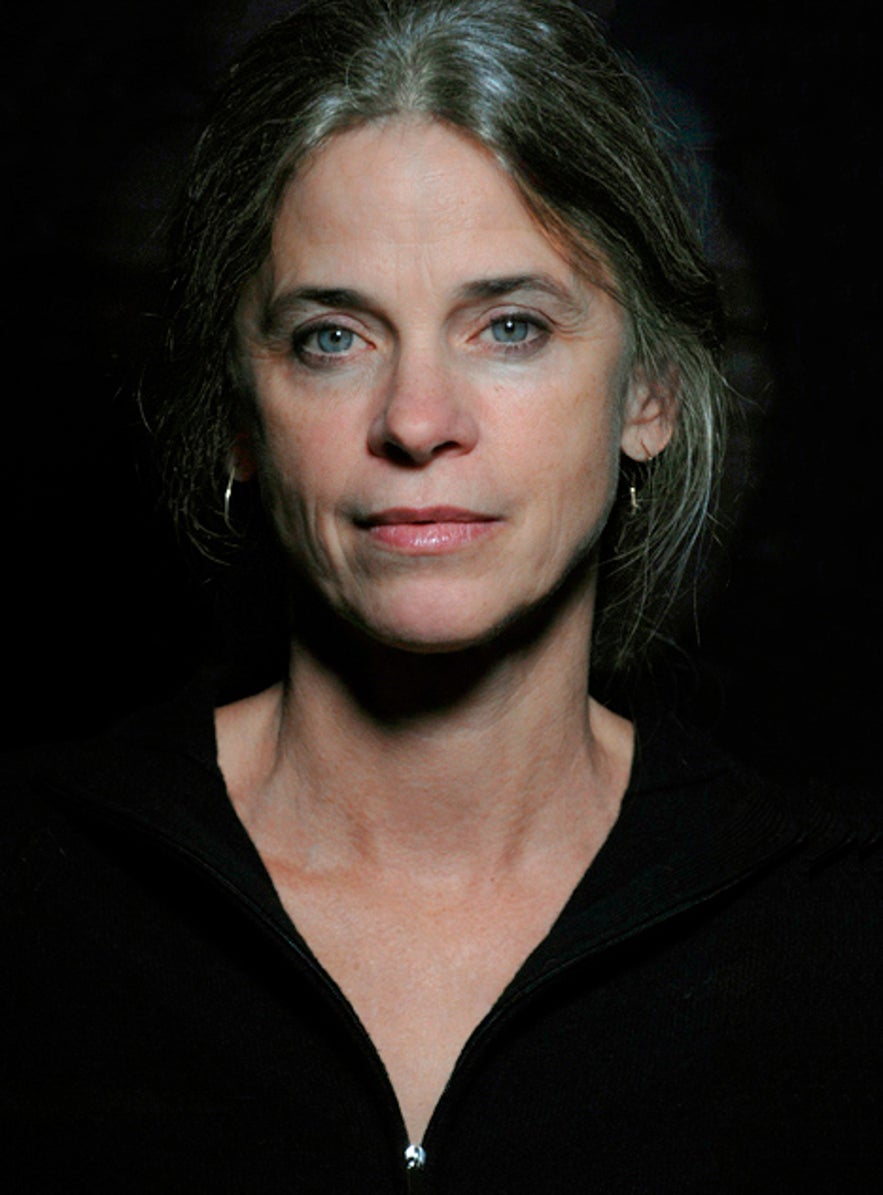 Sally Mann. Photo by: 'Michelle Hood, Creative Commons'.
Sally Mann. Photo by: 'Michelle Hood, Creative Commons'.
Working primarily in large format wet plate collodion, the landscapes by Sally Mann are exercises in the beauty of imperfection. Due to the wet plate process itself, many – if not all – of her images carry “flaws” that somehow impart a sense of wonderful individuality.
You can find more of Sally’s story and her photographs here. Note that some of her photographs might be disturbing or inappropriate to the eyes of some viewers. Please use your own discretion.
Essential Landscape Photography Techniques
As with any type of photography, working with landscapes carries its own set of nuances and intricacies. However, there are a few techniques and tips that will help you increase your chances of coming away with a landscape photo that you can be proud of on your next outing.
Technique #1. Shoot with a Small Aperture
Many landscape photos benefit from a large depth of field so that the entire image is in focus. This means shooting at apertures smaller than F/8.
Technique #2. Reduce Camera Shake
Camera shake is the enemy! Movement of your camera robs image sharpness so make sure you have a solid shooting platform such as a tripod and even a remote shutter release when making landscape photos.
Technique #3. Horizon Placement
Place your horizons in the upper or lower third of the frame. Learn more about this technique in our article, Rule of Thirds Explained.
Technique #4. Lighting
Make use of the Blue and Golden Hour. The time period just before and after sunset (Blue Hour) as well as the time just after sunrise and before sunset (Golden Hour) offer prime lighting opportunities. Shooting during these times can completely transform any landscape.
Final Thoughts on Landscape Photography
Making photographs of the landscape can be as simple or complex as you can imagine. Landscape photography, although extremely common, is still one of the most rewarding (not to mention the oldest) and prevalent types of photography practiced today. Any piece of land can be photographed as a “landscape” but it goes so much deeper than that. It’s up to you to inject your own creative and artistic vision into your work so that your photos reflect not only the landscape but a part of yourself as well.
About the author: Adam Welch is an adventurer, photographer and author based in the USA. You can find more of his work on his website or by following him on Facebook and YouTube.
Learn all about landscape photography on this 8 Day Summer Photography Workshop in Iceland. Our expert photography guides will ensure that you have a fun, educational experience during your next vacation!

